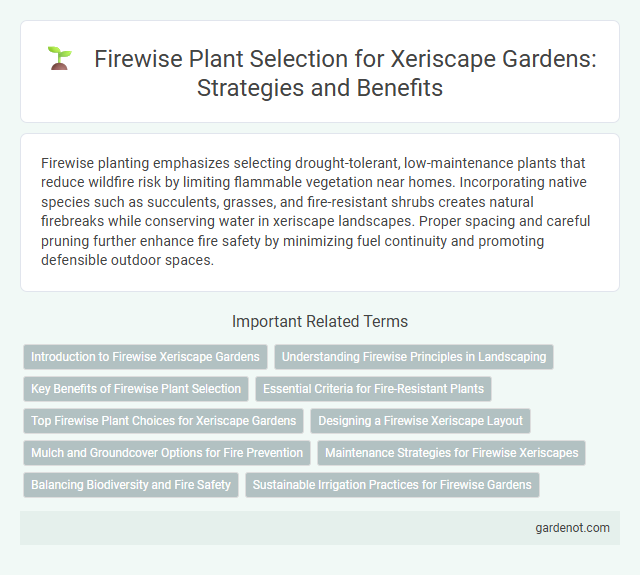Firewise planting emphasizes selecting drought-tolerant, low-maintenance plants that reduce wildfire risk by limiting flammable vegetation near homes. Incorporating native species such as succulents, grasses, and fire-resistant shrubs creates natural firebreaks while conserving water in xeriscape landscapes. Proper spacing and careful pruning further enhance fire safety by minimizing fuel continuity and promoting defensible outdoor spaces.
Introduction to Firewise Xeriscape Gardens
Firewise Xeriscape gardens use drought-tolerant plants and strategic spacing to reduce wildfire risks while conserving water. Incorporating native species like manzanita, ceanothus, and lavender enhances fire resistance and creates resilient landscapes. Proper mulch application and careful plant arrangement further protect properties by minimizing fuel loads and promoting safer firebreaks.
Understanding Firewise Principles in Landscaping
Firewise landscaping emphasizes selecting fire-resistant plants and maintaining proper spacing to reduce wildfire risks effectively. Incorporating low-flammability shrubs, native drought-tolerant species, and using non-combustible mulches enhances landscape resilience. Understanding fire behavior and integrating defensible space principles protects properties while promoting sustainable, xeriscape-friendly environments.
Key Benefits of Firewise Plant Selection
Firewise plant selection significantly reduces wildfire risk by incorporating species with high moisture content and low flammability, creating natural firebreaks in xeriscape landscapes. These plants not only conserve water but also enhance property protection, promoting safety without sacrificing aesthetic value. Choosing fire-resistant vegetation supports sustainable landscaping practices while maintaining ecological balance in arid regions.
Essential Criteria for Fire-Resistant Plants
Firewise planting emphasizes selecting fire-resistant plants that have high moisture content, low resin or sap levels, and minimal accumulation of dead or dry material. Plants with fleshy leaves, such as succulents, and those with low volatile oil content are preferred for reducing flammability. Maintaining proper spacing and regular pruning enhances the effectiveness of fire-resistant landscaping in xeriscape designs.
Top Firewise Plant Choices for Xeriscape Gardens
Top Firewise plant choices for xeriscape gardens include native succulents, such as agave and yucca, prized for their high moisture content and low flammability. Drought-tolerant shrubs like manzanita and ceanothus provide effective fire-resistant barriers while thriving in arid conditions. Incorporating firewise plants with thick, fleshy leaves and minimal dead material reduces ignition risks and enhances garden safety.
Designing a Firewise Xeriscape Layout
Designing a Firewise xeriscape layout involves selecting drought-tolerant, low-flammability plants such as succulents, native grasses, and fire-resistant shrubs like manzanita and ceanothus. Strategic plant placement should ensure adequate spacing between vegetation clusters to reduce fire spread, combined with creating firebreaks using hardscape elements like gravel or stone pathways. Incorporating mulch types that resist ignition, such as inorganic or rock mulches, further enhances the fire protection of xeriscaped areas while conserving water.
Mulch and Groundcover Options for Fire Prevention
Mulch and groundcover options play a crucial role in Firewise xeriscape design by reducing fire risk through moisture retention and minimizing flammable vegetation. Inorganic mulches such as gravel, decomposed granite, and crushed rock are preferred for fire prevention because they do not ignite, unlike organic mulches like bark or wood chips. Low-growing, fire-resistant groundcovers like creeping thyme, sedum, and ice plant create a living mulch that suppresses weeds and retains soil moisture, further enhancing fire safety in xeriscaping.
Maintenance Strategies for Firewise Xeriscapes
Firewise planting in xeriscape landscapes emphasizes regular maintenance strategies such as pruning dead or overgrown vegetation, removing leaf litter, and spacing plants to reduce fuel continuity and improve air circulation. Consistent irrigation practices tailored to drought-tolerant species prevent plant stress, minimizing flammability while conserving water. Implementing these maintenance actions supports fire-resistant landscape designs that enhance safety and sustainability in arid environments.
Balancing Biodiversity and Fire Safety
Firewise planting in xeriscape landscapes promotes balancing biodiversity and fire safety by selecting drought-tolerant native plants with low resin and oil content that minimize flame intensity. Incorporating diverse species with appropriate spacing reduces fire spread while supporting local ecosystems and pollinator habitats. Maintaining strategic plant clusters and fire-resistant ground covers enhances safety without compromising ecological resilience.
Sustainable Irrigation Practices for Firewise Gardens
Firewise planting in xeriscape gardens emphasizes sustainable irrigation practices that minimize water use while enhancing plant resilience to wildfire risks. Utilizing drip irrigation systems and selecting drought-tolerant, fire-resistant native species reduces fuel moisture and conserves water resources effectively. Proper mulch application and strategic plant spacing further optimize soil moisture retention and promote healthy growth, contributing to a safer, firewise landscape.
Firewise planting Infographic

 gardenot.com
gardenot.com